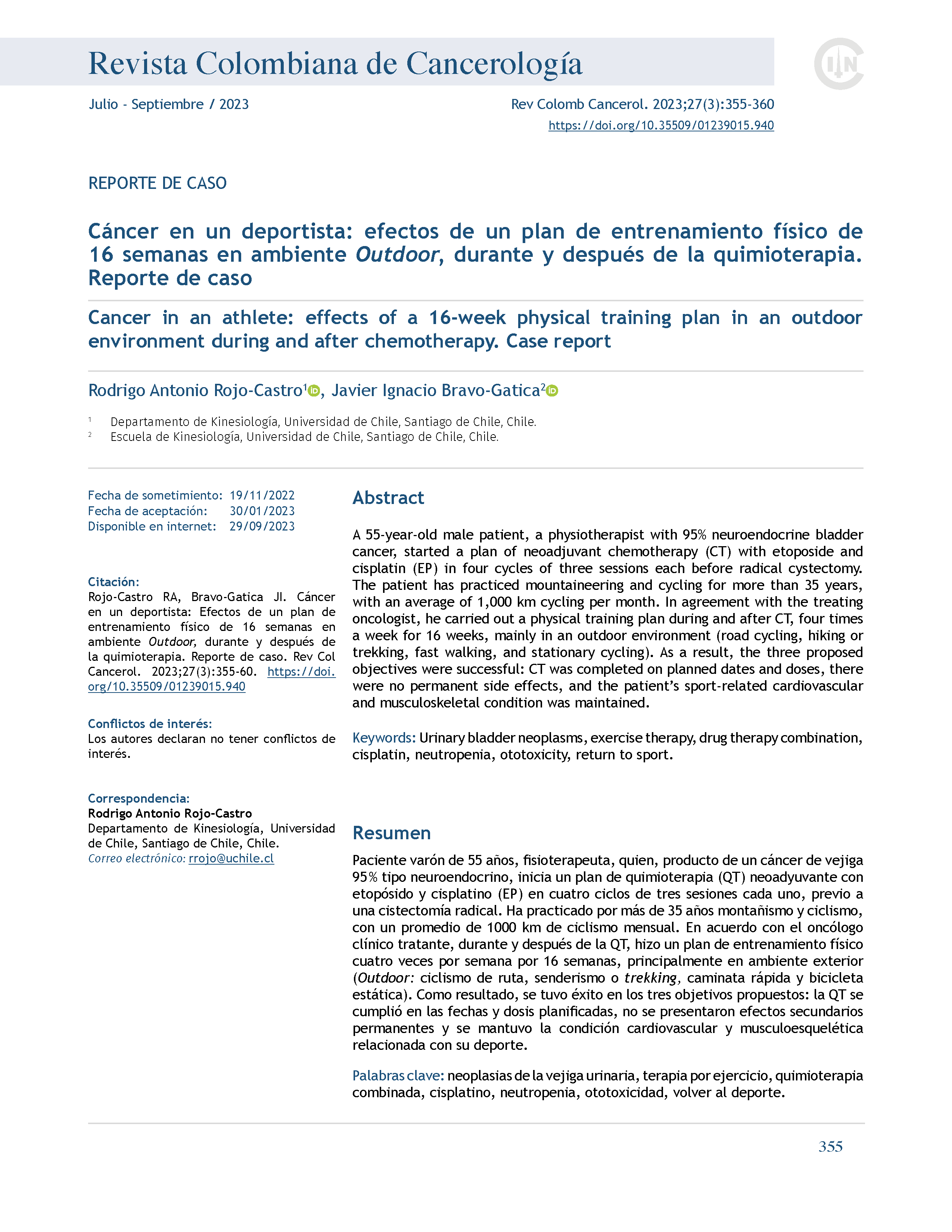Cáncer en un deportista: efectos de un plan de entrenamiento físico de 16 semanas en ambiente Outdoor, durante y después de la quimioterapia. Reporte de caso
DOI:
https://doi.org/10.35509/01239015.940Palabras clave:
neoplasias de la vejiga urinaria, terapia por ejercicio, quimioterapia combinada, cisplatino, neutropenia, ototoxicidad, volver al deporteResumen
Paciente varón de 55 años, fisioterapeuta, quien, producto de un cáncer de vejiga 95 % tipo neuroendocrino, inicia un plan de quimioterapia (QT) neoadyuvante con etopósido y cisplatino (quimioterapia [QT]-EP) en cuatro ciclos de tres sesiones cada uno, previo a una cistectomía radical. Ha practicado por más de 35 años montañismo y ciclismo, con un promedio de 1000 km de ciclismo mensual. En acuerdo con el oncólogo clínico tratante, durante y después de la QT, hizo un plan de entrenamiento físico cuatro veces por semana por 16 semanas, principalmente en ambiente exterior (Outdoor: ciclismo de ruta, senderismo o trekking, caminata rápida y bicicleta estática). Como resultado, se tuvo éxito en los tres objetivos propuestos: la QT se cumplió en las fechas y dosis planificadas, no se presentaron efectos secundarios permanentes y se mantuvo la condición cardiovascular y musculoesquelética relacionada con su deporte.
Biografía del autor/a
Rodrigo Antonio Rojo-Castro, Departamento de Kinesiología, Universidad de Chile, Santiago de Chile, Chile.
1. Departamento de Kinesiología, Universidad de Chile, Santiago de Chile, Chile.
Javier Ignacio Bravo-Gatica, Escuela de Kinesiología, Universidad de Chile, Santiago de Chile, Chile.
2. Escuela de Kinesiología, Universidad de Chile, Santiago de Chile, Chile.
Referencias bibliográficas
Muñoz I, Briceño C, Figueroa G. Manejo multidisciplinario: una propuesta para mejorar la calidad de vida del paciente oncológico en quimioterapia. Rev Hosp Clin Univ Chile. 2013;24:142-9. https://www.redclinica.cl/Portals/0/Users/014/14/14/Publicaciones/Revista/manejo_multi_paciente_oncologico.pdf
Ferreira R. Neuropatía sensorial periférica induzida pela cisplatina: estudo dos mecanismos de neurotoxicidade da cisplatina e do efeito protetor do éster fenetil do acido cafeico (CAPE) em células PC12 [Tesis doctoral]. Sao Paulo. Facultad de Ciencias Farmaceuticas de Riberao Preto, Universidad de Sao Paulo 2018. Disponible en: https://www.teses.usp.br/teses/disponiveis/60/60134/tde-17102018-104638/publico/Tese_Simplificada_original.pdf
Tórtola-Navarro A, Santalla A. Fatiga relativa al cáncer: factores desencadenantes y función del ejercicio físico. Arch Med Deporte. 2021;38(3):209-19. https://doi.org/10.18176/archmeddeporte.00045
Knols R, Aaronson N, Uebelhart D, Fransen J, Aufdemkampe G. Physical exercise in cancer patiens during and after medical treatments: A systematic review of randomized and controlled clinical trials. J Clin Oncol. 2005;23(16):3830-42. https://doi.org/10.1200/jco.2005.02.148
Segal R, Zwaal C, Green E, Tomasone J, Loblaw A, Petrella T. Exercise for people with cancer: a sistematic review. Curr. Oncol. 2017;24(4):290-315. https://doi.org/10.3747/co.24.3619
Dimeo F, Fetscher S, Lange W, Mertelsmann R, Keul J. Effects of aerobic exercise on the physical performance and incidence of treatment-related complications after high-dose chemotherapy. Blood. 1997;90(9):3390-4. https://doi.org/10.1182/blood.V90.9.3390
Schauer T, Hojman P, Gehl J, Christensen J. Exercise training as prophylactic strategy in the management of neutropenia during chemotherapy. Br J Pharmacol. 2020;179(12):2925-37. https://doi.org/10.1111/bph.15141
Cunningham B, Morris G, Cheney C. Effects of resistive exercise on skeletal muscle in marrow transplant recipients receiving total parenteral nutrition. J Parenter Enteral Nutr. 1986;10(6):558-63. https://doi.org/10.1177/0148607186010006558
Courneya K, Segal R, Mackey J, Gelmon K, Reid R, Friedenreich M, et al. Effects of aerobic and resistance exercise in breast cancer patients receiving adjuvant chemotherapy: a multicenter randomized controlled trial. J Clin Oncol. 2007;25(28):4396-404. https://doi.org/10.1200/JCO.2006.08.2024
Courneya K, McKenzie D, Mackey J, Gelmon K, Friedenreich C, Yasui Y, et al. Effects of exercise doce and type during breast cancer chemotherapy: multicenter randomized trial. J Natl Cancer Inst. 2013;105(23):1821-32. https://doi.org/10.1093/jnci/djt297
Courneya K, McKenzie D, Mackey J, Gelmon K, Friedenreich C, Yasui Y, et al. Subgroup effects in a randomised trial of different types and doses of exercise during breast cancer chemotherapy. Br J Cancer. 2014;111(9):1718-25. https://doi.org/10.1038/bjc.2014.466
Schwartz A. Patterns of exercise and fatigue in physically active cancer survivors. Oncol Nurs Forum. 1998;25(3):485-91. https://pubmed.ncbi.nlm.nih.gov/9568604/
Schwartz A, Terry C. Returning to sport: Female athletes living with and beyond cancer. Int. J. Environ. Res. Public Health. 2021;18(15):8151. https://doi.org/10.3390/ijerph18158151
Savage P, Dittus K, Lakoski S. Fitness during breast cancer treatment and recovery in an athlete a case study. Med Sci Sports Exerc. 2016;48(10):1893-97. https://doi.org/10.1249/MSS.0000000000000987
Cómo citar
Descargas

Descargas
Publicado
Número
Sección
Licencia
Derechos de autor 2023 Revista Colombiana de Cancerología

Esta obra está bajo una licencia internacional Creative Commons Atribución-NoComercial-SinDerivadas 4.0.
Todos los derechos reservados.

| Estadísticas de artículo | |
|---|---|
| Vistas de resúmenes | |
| Vistas de PDF | |
| Descargas de PDF | |
| Vistas de HTML | |
| Otras vistas | |


